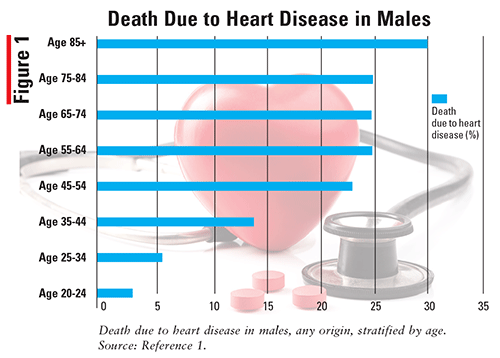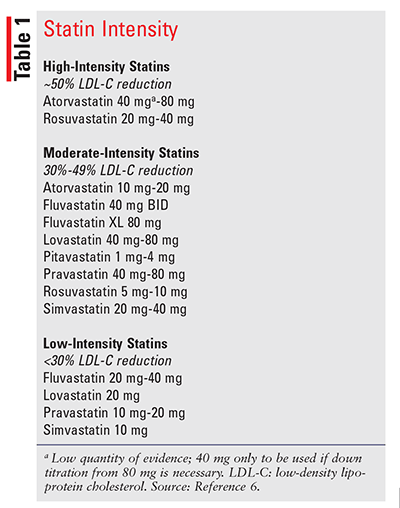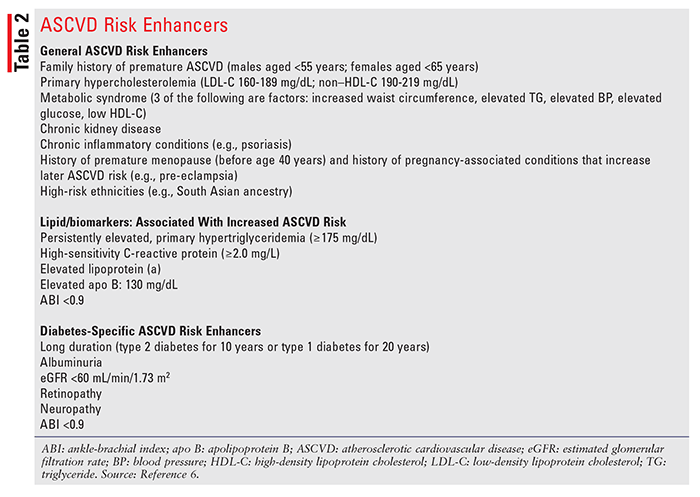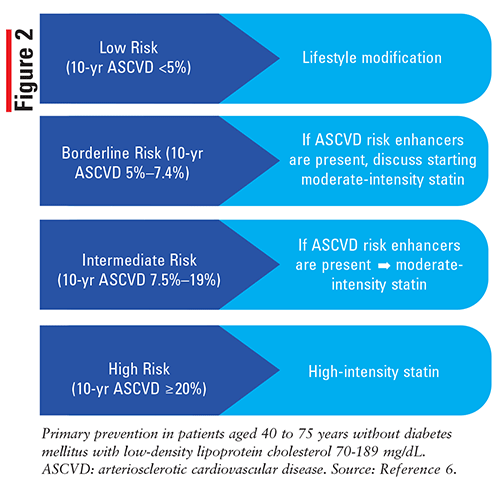US Pharm;2020;45(6):HS-1-HS-10.
ABSTRACT: Heart disease is the number-one cause of death in males. The risk for death increases with age. Preventing cardiovascular disease is important to decrease the associated morbidity and mortality. This can be achieved through the management of modifiable risk factors or pharma-cologic interventions targeting primary prevention, such as aspirin and statins. Because the data in this area are ever-changing, it is important to keep up-to-date with current guidelines. Pharmacists are well positioned to assist patients with recommendations on these interventions to decrease their cardiovascular risk.
ABSTRACT: Heart disease is the number-one cause of death in males. The risk for death increases with age. Preventing cardiovascular disease is important to decrease the associated morbidity and mortality. This can be achieved through the management of modifiable risk factors or pharma-cologic interventions targeting primary prevention, such as aspirin and statins. Because the data in this area are ever-changing, it is important to keep up-to-date with current guidelines. Pharmacists are well positioned to assist patients with recommendations on these interventions to decrease their cardiovascular risk.
Heart disease is the leading cause of death in males.1 The 2017 National Vital Statistics Report states that 24.2% of all deaths in men can be attributed to heart disease.1 The mortality risk increases in male patients aged 45 years and older (FIGURE 1).1 Risk factors for heart disease include tobacco smoking, physical inactivity, improper nutrition, obesity, dyslipidemia, hypertension, diabetes mellitus, metabolic syndrome, and kidney disease.2

Around 17.5% of the adult male population smokes tobacco.2 The risk of morbidity and mortality due to cardiovascular disease (CVD) decreases with smoking cessation, regardless of whether a patient has established CVD.2 Physical inactivity is another modifiable risk factor.2 A correlation between increased sedentary time and greater CVD risk has been identified.2 The Physical Activity Guidelines for Americans suggest that adults engage in at least 150 minutes of moderate-intensity, aerobic activity per week and muscle-strengthening exercises at least 2 days per week.3,4 According to the 2016 National Health Interview Survey, around 26% of males reported meeting these guidelines.2 Poor dietary habits, such as high sodium intake and low vegetable intake, are associated with CVD.2 Just under 50% of CVD mortality in men is attributable to a less than optimal diet.2 Poor diet and sedentary lifestyle increase the risk of obesity (another CVD risk factor), of which 40% of males aged 20 years and older are classified.2
Hypertension is the number-one CVD risk factor.2 Elimination of hypertension can decrease mortality among males by 30%.2 The prevalence of hypertension in males decreased from 33% in 1980 to 29% in 2008.2 In patients with diabetes mellitus, the leading cause of morbidity and mortality is CVD.5 Diabetes is considered to be an independent CVD risk factor.2 Diabetes prevalence has been on the rise in men, with the latest report indicating a 119% increase between 1990 and 2016.2 While the relative risk of CVD related to metabolic syndrome is higher in females, it is still present in males.2 It is estimated that approximately 24% of the male population lives with metabolic syndrome.2 Chronic kidney disease (CKD) is another CVD risk factor.2 In patients aged 66 years or older, CVD was present in almost two-thirds of patients with CKD.2 Patients with CKD are more likely to die from CVD than to progress to end-stage renal disease.2 Another significant CVD risk factor is dyslipidemia, predominately associated with low-density lipoprotein cholesterol (LDL-C).2,6 Thirty percent of males aged 20 years and older have an LDL-C of 130 mg/dL or greater.2
The goal of primary prevention is to decrease cardiovascular (CV) risk in patients who have not already had a CV event. The majority of data for primary prevention surrounds the use of aspirin and statins. Data on primary prevention are ever-changing, and keeping up-to-date with the current recommendations is paramount.
ASPIRIN FOR PRIMARY PREVENTION
Aspirin irreversibly inhibits the formation of thromboxane A2, preventing platelet aggregation.7 For years, it has been thought that taking low-dose aspirin daily would prevent thrombotic events, such as myocardial infarction (MI) and stroke in patients without a history of CVD. The data are mixed regarding the efficacy of aspirin for this indication, and this leaves healthcare professionals, including pharmacists, in a challenging predicament. Having a firm grasp on the available data and current guideline recommendations is vital to determine if use of this therapy is warranted.
Multiple guidelines are available that provide recommendations for aspirin use for primary prevention. The most recent U.S. Preventive Services Task Force (USPSTF) recommendations were published in 2016 and advise the use of low-dose aspirin for primary prevention of CVD in adults aged 50 to 59 years if their 10-year risk of CVD is ³10%. It also states that the patient must be willing to use aspirin for at least 10 years to gain a benefit. For patients aged 60 to 69 years with a 10-year risk of CVD ³10%, the recommendation is weaker: It advises deciding to use aspirin on a case-by-case basis. For patients younger than age 50 years or those aged 70 years and older, it states the risk-versus-benefit assessment of aspirin cannot be determined because insufficient data are available. In addition, the USPSTF identifies patients at increased bleeding risk, which includes older age, male sex, and havig diabetes.8 (The USPSTF is currently updating these recommendations.)
The 2016 European Guidelines on Cardiovascular Disease Prevention in Clinical Practice recommend against the use of aspirin for patients without documented CVD, due to the increased bleeding risk.9 The 2019 American College of Cardiology (ACC) published a guideline on CVD primary prevention in 2019. It states that low-dose aspirin can be considered in patients aged 40 to 70 years whose atherosclerotic cardiovascular disease (ASCVD) risk is higher than their bleeding risk. They also recommend avoiding aspirin in patients over age 70 years.10 Unfortunately, none of these guidelines specify how these recommendations apply to patients based on gender. It is well established that male patients have a higher risk of CVD compared with females.2,11 To determine how to apply these recommendations to a male patient, we must dive into the literature and assess what we know about the use of aspirin for primary prevention in men.
The use of aspirin for primary prevention has been studied for decades. Two of the largest trials assessing its use for primary prevention found mixed results. Each of these studies included only male patients. The U.S. Physician Health Study published in 1989 found a reduction in MI, but an increase in bleeding, in healthy male physicians using aspirin 325 mg every other day for 5 years.12 However, a year earlier, the British Doctors Study found no benefit of aspirin use in male physicians using aspirin 500 mg daily for 6 years.13
Numerous other studies were published over the following 2 decades with mixed results. The HOT trial found that aspirin reduced major CV events, morespecifically MI. No difference in stroke or CV death was found. Nonfatal major and minor bleeding was more common with aspirin use.14 About half of the patients in this trial were men. The PPP trial assessed the use of aspirin 100 mg daily or placebo in patients aged 65 years or older with at least one CVD risk factor, such as hypertension, dyslipidemia, or diabetes; just over 40% of patients were male. The average age was 64 years, about 70% had hypertension, about 40% had dyslipidemia, and 17% had diabetes. Nearly 70% of the patients had two or more CVD risk factors. Aspirin resulted in fewer CV events and deaths. When assessed individually, no difference was found in MI and stroke. Higher rates of gastrointestinal (GI) bleeding and GI disease occurred with aspirin.15 Unfortunately, neither trial assessed the effects of aspirin based on gender.
Since data are conflicting, multiple meta-analyses have been conducted. In 2006, Berger and colleagues published a meta-analysis including assessment results based on gender. Six trials were included in this analysis using aspirin doses between 75 mg and 500 mg daily. In male patients, aspirin reduced CV events, driven by reduction in MI. No benefit was found in stroke or CV death. Aspirin increased major bleeding and hemorrhagic stroke.16 The ATT meta-analysis included six studies assessing aspirin dosed between 75 and 500 mg daily in studies including male patients. Aspirin reduced vascular events driven by a reduction in MI. No difference in CV death or all-cause death was seen. When vascular events were assessed based on gender, male patients benefitted from aspirin use, with fewer serious vascular events. When assessed based on 5-year CVD risk, patients with a risk score greater than 10% had a greater reduction in CVD events compared with lower risk patients. No difference in stroke was found. Aspirin increased GI and extracranial bleeding.17
Since 2018, three well-designed trials have been published assessing the efficacy and safety of aspirin for primary prevention of CVD. The ARRIVE trial followed patients for 5 years and included men at least age 55 years with multiple CVD risk factors. The study also included women, but over 70% were male. Patients were excluded if they had diabetes. On average, patients were about age 64 years, most were white, over half had hypertension and dyslipidemia, and 29% of patients smoked. The average ASCVD score was 17.3%. Patients received aspirin 100 mg daily or placebo. A reduction was found in MI with aspirin (0.98% vs. 1.84%, (number needed to treat [NNT] = 116) without any reduction in death or stroke. This benefit was seen only in patients who reliably took the aspirin daily (per protocol population). This benefit came at the expense of an increase in GI bleeding (0.97% vs. 0.46% (number needed to harm [NNH] = 196). No difference was found based on gender.18
The ASCEND trial included patients aged 40 years and older with diabetes. Patients were followed for 7.4 years. Over 60% of patients were men. On average, patients were about age 63 years, most were white, over half had hypertension and dyslipidemia, and about 8% were current smokers. When assessed, 40.5%, 42.3%, and 17.2% had low, moderate, and high vascular risk, respectively. Patients received aspirin 100 mg daily or placebo. The composite of nonfatal MI, nonfatal stroke, transient ischemic attack, or death from any vascular cause was lower with aspirin (8.5% vs. 9.6%, NNH = 91). This endpoint was driven by a reduction in serious vascular events with no difference in MI or stroke. This benefit came at the cost of increased serious GI bleeding (1.8% vs. 1.3%, NNH = 200) and major bleeding (4.1% vs. 3.2%, NNH = 111). The benefit of aspirin was greater in patients with higher ASCVD risk at baseline. Aspirin was associated with a reduction in the composite of serious vascular events or revascularization in men.19
The ASPREE trial assessed patients receiving aspirin 100 mg daily or placebo for primary prevention of CVD for 4.7 years. Patients were included if they were age 70 years or older (or age 65 years or older if they were African American or Hispanic). No difference was found in CV death; however, an increase in all-cause mortality was discovered in patients taking aspirin (5.9% vs. 5.2%, NNH = 142). When assessed based on gender, male patients were found to have an increase in all-cause mortality with aspirin. Most deaths in the patients taking aspirin were a result of cancer, and not CVD or bleeding.20
A 2019 meta-analysis by Gelbenegger and colleagues included 13 trials with over 160,000 patients, including the three trials just discussed. The average patient age was 62 years, and they were followed for 6.4 years. Aspirin doses ranged from 75 mg to 500 mg daily. Aspirin reduced major adverse CV events (MACE) by 0.052% (NNT = 1,908) and MI by 0.041% (NNT = 2,452). Aspirin increased the risk of major bleeding by 0.077% ( [NNH] = 1,295), with the most common bleeds being extracranial and GI. No differences were found in intracranial bleeding or hemorrhagic stroke. This analysis also assessed the net clinical benefit of aspirin. When weighing benefits versus risk, the authors determined that aspirin provided no net clinical benefit. Nine of the studies were assessed to determine the effect of aspirin in men. MACE was reduced in male patients; however, MI and stroke were not.21
Unfortunately, despite newer data, a clear role of aspirin for primary prevention of CVD cannot be determined; however, it can be seen that the risk does exist. It seems that far fewer patients than we once thought may be candidates for aspirin use. Thus, the decision for aspirin use in a male patient for primary prevention should be made on a case-by-case basis. For low-risk patients with no CVD risk factors, the risk of aspirin will outweigh the benefit. For patients with high CVD risk, especially those with uncontrolled comorbidities, aspirin therapy can be considered. It should be used only in patients willing to take the medication for at least 5 years and in patients whose adherence can be guaranteed. These patients should not be taking other medications that increase bleed risk (i.e., nonsteroidal anti-inflammatory drugs [NSAIDs] or anticoagulants).
STATINS FOR PRIMARY PREVENTION
Unlike the aspirin data, which is controversial, statin data show consistent results supporting its use in primary prevention, as noted in the guidelines. While the statin data does not identify differences specific for use in men versus women, the majority of the population in the clinical trials were men, which strengthens the external validity of this data to the male population.22-24 Another noticeable difference is that men are less likely to experience myalgias compared with women.25 The 2018 American Heart Association (AHA)/ACC Guideline on the Management of Blood Cholesterol groups patients who are most likely to receive CV risk reduction from the use of a statin.6 Of these four statin benefit groups, three are primary prevention: 1) severe hypercholesterolemia; 2) diabetes mellitus in adults aged 40 to 75 years with LDL-C 70-189 mg/dL; and 3) primary prevention over the life span.6
Severe Hypercholesterolemia
In patients with severe hypercholesterolemia (LDL-C of 190 mg/dL or greater), a high-intensity statin (TABLE 1) is recommended.6 Statin use in this patient population showed a decreased incidence of MI and CV death. If a patient cannot tolerate a high-intensity statin, the maximally tolerated statin should be prescribed. ASCVD risk calculation is not necessary in this patient population due to the high lifetime risk of ASCVD.6

Diabetes Mellitus in Adults Aged 40-75 Years With LDL-C 70-189 mg/dL
The next statin benefit group encompasses patients aged 40 to 75 years with diabetes mellitus and an LDL-C between 70 and 189 mg/dL. These patients should be initiated on a moderate-intensity statin, regardless of their 10-year ASCVD risk estimation. Significant reduction in ASCVD events was demonstrated with treatment using moderate-intensity statins, signifying a 25% risk reduction. This benefit was seen in both patients with type 1 or type 2 diabetes. Some patients in this group may benefit from a high-intensity statin (TABLE 2).6

Primary Prevention Over the Life Span
Patients who do not fall into the aforementioned groups and do not have clinical ASCVD should be stratified by age and other risk enhancers to determine if a statin will be of benefit. Patients aged 0 to 19 years should only receive a statin if they have been diagnosed with familial hypercholesterolemia or if they have a persistently elevated LDL-C ³190 mg/dL and do not respond adequately to lifestyle changes.6
A lifetime ASCVD risk estimation should be calculated for patients aged 20 to 39 years. The ASCVD Risk Estimator Plus is available at http://tools.acc.org/ASCVD-Risk-Estimator-Plus. Statins can be considered in this age group if the patient has a family history of ASCVD, premature ASCVD, and LDL-C of 160 mg/dL or greater.6
When we consider the age group of 40 to 75 years (LDL-C 70-189 mg/dL without diabetes mellitus), things become more complicated. A 10-year ASCVD risk estimation will determine the next steps for this patient group (FIGURE 2).6

In all patients aged 75 years or older, clinical assessment and risk discussion should occur to determine the need for statin therapy. Due to limited amounts of data, recommendations in this patient population are worded as suggestions. Moderate-intensity statins are recommended if the LDL-C is between 70 and 189 mg/dL. The suggestion to deprescribe is also made for patients who are exhibiting functional decline, frailty, multimorbidity, or decreased life expectancy.6
Role of the Pharmacist
As one of the most easily accessible healthcare providers, pharmacists play a vital role in the appropriate use of aspirin and statin therapy. More importantly, with aspirin being an OTC product, some patients may not realize the importance of informing their providers about its use. Whether a pharmacist practices in the inpatient or outpatient setting, he or she can perform medication reconciliation. By gathering a reliable and complete medication list, the pharmacist can determine if there are any medications increasing a patient’s risk of bleeding, which may prevent aspirin use or result in a drug interaction with a statin. Also, pharmacists should counsel patients on the importance of adherence. As seen with the aspirin data and USPSTF recommendations (as well as with statin data), the benefits of these therapies come with daily use for many years. Patients should be educated on this duration of therapy.
Pharmacists can also assess a patient’s CVD and bleed risk. By using validated assessment tools such as the ASCVD Risk Estimator Plus, pharmacists can inform patients of their risk of CVD and balance it with the potential harm.26 Medication therapy management is an excellent opportunity for pharmacists to identify whether a patient falls into a statin benefit group. If so, the pharmacist can educate the patient and contact the prescriber as part of the Comprehensive Medication Review.
Another helpful tool is the Aspirin Guide (available at www.aspiringuide.com/nav/1). This tool calculates a patient’s 10-year ASCVD risk score as well as a bleeding risk score. These values can be weighed to assess risk versus benefit. As there are not straightforward, clear recommendations or data supporting the use of aspirin for CVD primary prevention, pharmacists should discuss the risk versus benefits with each patient. If it is determined that aspirin use is warranted for primary prevention, pharmacists should recommend the appropriate dose of 81 mg daily.
Finally, pharmacists can use motivational interviewing and the Pharmacist Patient Care Process to ensure that appropriate steps are taken when interacting with patients.27 Since aspirin and statins rarely make a patient feel different or better, nonadherence is a common issue. Motivational interviewing can help the pharmacist discover a patient’s opinions and goals. This information can be used to tailor counseling to enhance patient buy-in and develop a stronger relationship. All of these strategies will increase the patient’s likelihood of meeting the therapeutic goals set by both the patient and the healthcare providers.
REFERENCES
1. Heron M. Deaths: Leading Causes for 2017. Natl Vital Stat Rep. 2019;68(6):1-77.
2. Benjamin EJ, Muntner P, Alonso A, et al. Heart Disease and Stroke Statistics—2019 Update: A Report From the American Heart Association. Circulation. 2019;139(10).
3. 2008 Physical Activity Guidelines for Americans. https://health.gov/our-work/physical-activity/previous-guidelines/2008-physical-activity-guidelines
4. Physical Activity Guidelines for Americans, 2nd edition. https://health.gov/our-work/physical-activity/current-guidelines
5. American Diabetes Association. Cardiovascular Disease and Risk Management: Standards of Medical Care in Diabetes—2020. Diabetes Care. 2020;43(Supplement 1):S111-S134.
6. Grundy SM, Stone NJ, Bailey AL, et al. 2018 AHA/ACC/AACVPR/AAPA/ABC/ACPM/ADA/AGS/APhA/ASPC/NLA/PCNA Guideline on the Management of Blood Cholesterol. J Am Coll Cardiol. 2019;73(24):e285-e350.
7. DailyMed. BAYER–aspirin tablet. https://dailymed.nlm.nih.gov/dailymed/lookup.cfm?setid=7f5d9ebe-8119-49a2-9380-eca18a5e5e85. Accessed April 7, 2020.
8. Aspirin Use for the Primary Prevention of Cardiovascular Disease and Colorectal Cancer: Recommendations From the U.S. Preventive Services Task Force. Ann Intern Med. 2016;164(12).
9. Piepoli MF, Hoes AW, Agewall S, et al. 2016 European Guidelines on cardiovascular disease prevention in clinical practice: The Sixth Joint Task Force of the European Society of Cardiology and Other Societies on Cardiovascular Disease Prevention in Clinical Practice (constituted by representatives of 10 societies and by invited experts) Developed with the special contribution of the European Association for Cardiovascular Prevention & Rehabilitation (EACPR). Eur Heart J. 2016;37(29):2315-2381.
10. Arnett DK, Blumenthal RS, Albert MA, et al. 2019 ACC/AHA Guideline on the Primary Prevention of Cardiovascular Disease: A Report of the American College of Cardiology/American Heart Association Task Force on Clinical Practice Guidelines. J Am Coll Cardiol. 2019;74(10):e177-e232.
11. CDC. Heart Disease Facts. Centers for Disease Control and Prevention. www.cdc.gov/heartdisease/facts.htm. Published December 2, 2019. Accessed April 7, 2020.
12. Steering Committee of the Physicians’ Health Study Research Group. Final report on the aspirin component of the ongoing Physicians’ Health Study. N Engl J Med. 1989;321(3):129-135.
13. Peto R, Gray R, Collins R, et al. Randomised trial of prophylactic daily aspirin in British male doctors. Br Med J Clin Res Ed. 1988;296(6618):313-316.
14. Hansson L, Zanchetti A, Carruthers SG, et al. Effects of intensive blood-pressure lowering and low-dose aspirin in patients with hypertension: principal results of the Hypertension Optimal Treatment (HOT) randomised trial. HOT Study Group. Lancet Lond Engl. 1998;351(9118):1755-1762.
15. de Gaetano G, Collaborative Group of the Primary Prevention Project. Low-dose aspirin and vitamin E in people at cardiovascular risk: a randomised trial in general practice. Collaborative Group of the Primary Prevention Project. Lancet Lond Engl. 2001;357(9250):89-95.
16. Berger JS, Roncaglioni MC, Avanzini F, et al. Aspirin for the primary prevention of cardiovascular events in women and men: a sex-specific meta-analysis of randomized controlled trials. JAMA. 2006;295(3):306-313.
17. Baigent C, Blackwell L, et al. Antithrombotic Trialists’ (ATT) Collaboration. Aspirin in the primary and secondary prevention of vascular disease: collaborative meta-analysis of individual participant data from randomised trials. Lancet Lond Engl. 2009;373(9678):1849-1860.
18. Gaziano JM, Brotons C, Coppolecchia R, et al. Use of aspirin to reduce risk of initial vascular events in patients at moderate risk of cardiovascular disease (ARRIVE): a randomised, double-blind, placebo-controlled trial. Lancet Lond Engl. 2018;392(10152):1036-1046.
19. ASCEND Study Collaborative Group, Bowman L, Mafham M, et al. Effects of aspirin for primary prevention in persons with diabetes mellitus. N Engl J Med. 2018;379(16):1529-1539.
20. McNeil JJ, Nelson MR, Woods RL, et al. Effect of Aspirin on all-cause mortality in the healthy elderly. N Engl J Med. 2018;379(16):1519-1528.
21. Gelbenegger G, Postula M, Pecen L, et al. Aspirin for primary prevention of cardiovascular disease: a meta-analysis with a particular focus on subgroups. BMC Med. 2019;17(1):198.
22. Downs JR, Clearfield M, Weis S, et al. Primary prevention of acute coronary events with lovastatin in men and women with average cholesterol levels: results of AFCAPS/TexCAPS. JAMA. 1998;279(20):1615-1622.
23. Ridker PM, Danielson E, Fonseca FA, et al. Rosuvastatin to prevent vascular events in men and women with elevated C-reactive protein. N Engl J Med. 359 (2008):2195-2207.
24. Baigent C, Blackwell L, Emberson J, et al. Efficacy and safety of more intensive lowering of LDL cholesterol: a meta-analysis of data from 170,000 participants in 26 randomised trials. Lancet. 2010; 376(9753):1670-1681.
25. Newman CB, Preiss D, Tobert JA, et al. Statin safety and associated adverse events: a scientific statement from the American Heart Association. Arterioscler Thromb Vasc Biol. 2019;39:e38-e81.
26. Lloyd-Jones DM, Huffman MD, Karmali KN, et al. Estimating longitudinal risks and benefits from cardiovascular preventive therapies among Medicare Patients: The Million Hearts Longitudinal ASCVD Risk Assessment Tool: A Special Report From the American Heart Association and American College of Cardiology. J Am Coll Cardiol. 2017;69(12):1617-1636.
27. The Pharmacists’ Patient Care Process–JCPP. https://jcpp.net/patient-care-process/. Accessed April 9, 2020.
To comment on this article, contact rdavidson@uspharmacist.com.
The content contained in this article is for informational purposes only. The content is not intended to be a substitute for professional advice. Reliance on any information provided in this article is solely at your own risk.





